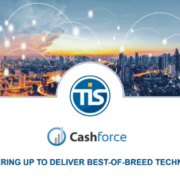Cash forecasting: A data story
| 17-01-2018 | Cashforce |
 Have you ever heard the dogma that people only use 10% of their brain capacity? Fortunately, this statement is a myth, but a similar (and more truthful) argument can be made for data usage. Using the example of an oil rig, a 2015 McKinsey & Company report states that an organisation typically uses less than 1% of the collected data to make decisions. While intuitively not all data will be useful to include in the decision-making process, it’s fair to say that there is a huge untapped potential.
Have you ever heard the dogma that people only use 10% of their brain capacity? Fortunately, this statement is a myth, but a similar (and more truthful) argument can be made for data usage. Using the example of an oil rig, a 2015 McKinsey & Company report states that an organisation typically uses less than 1% of the collected data to make decisions. While intuitively not all data will be useful to include in the decision-making process, it’s fair to say that there is a huge untapped potential.
From advanced retargeting in the marketing world to tailored music suggestions on Spotify, data has been in an uplift, opening doors in almost every field. Corporate finance & treasury is sitting pretty as well: amongst other areas, integrating relevant data into your forecasting model can facilitate substantial improvements in the quality of your cash flow predictions.
In this exuberant amount of data, it’s important to distinguish internal from external data.
Internal corporate data
Put simply, the bulk of data involved in cash projections will be found internally. Standard forecasting models, mostly build in spreadsheets, often make use of a small part of these data. Both account balances grabbed from banking portals and user generated input contribute to fulfil the daily, weekly or monthly cash forecast. User generated data may contain sales budget & forecast, average incoming & outgoing cash flows, projected dividends, CAPEX investments, etc. This information is necessary however typically lacks accuracy.
When making smart use of additional internal business data, most of these estimates can be derived from other internal data that may lead to a higher degree of forecast accuracy and a maintainable forecasting model. Such internal data sources are numerous and contain information on sales & purchase orders, quotations from your CRM system, production planning & all kind of recurring activities that carry relevant information on your future cash flows. Additionally, treasury data can automatically be included as well, enabling your treasury department to be multiple steps ahead instead of running behind daily facts.
To maximize the potential of your internal (big) data, algorithms and calculations need to be added to the forecasting model. By incorporating customer payment behaviour, seasonality patterns, correlations between different types of cash flows… your predictions can easily benefit from fine-tuning of these basic parameters. Re-evaluating those assumptions can by looking at meaningful patterns that are present in the data, can help to make a smarter and more tailored forecast. As an example, by carefully looking at past payment periods, future payments for each customer can be estimated with a high degree of precision.
External data
Finally, integrating external data in your forecasting model will typically not affect cash the forecast in the short-term. It can however be relevant for long-term cash projections and fine-tuning. Market sentiment and macro economical indices will be most useful here, as well as all ticker information on treasury & commodity futures.
After capturing all this data, it’s key to consolidate everything from several (usually incompatible) operational systems. Note that not only the amount of data and diversity of data sources are important, but the accuracy of input and up-to-date information as well.
Consequentially, through extensive modelling and analysis, an effective and accurate cash flow forecast can be created. For this you would need software that can handle advanced big data analytics in order to convey pattern recognition and forecasting. The lion’s share of prevailing software doesn’t have the necessary integration possibilities and processing power to efficiently effectuate these kind of complex consolidation and analyses. Fortunately, some are built with this data requirements in mind and do have these capabilities. These make room for generating a significantly better cash forecast.
The world of business is going through rapid advancement in this age of technology, and the financial discipline is not spared in this phenomenon. While this data story unfolds, the time has come to put your “corporate brain-capacity” to use. Will you let this wealth of data create an unseen amount of value?
If you want to find out more about Cashforce and their services and products please refer to their company profile on treasuryXL.











